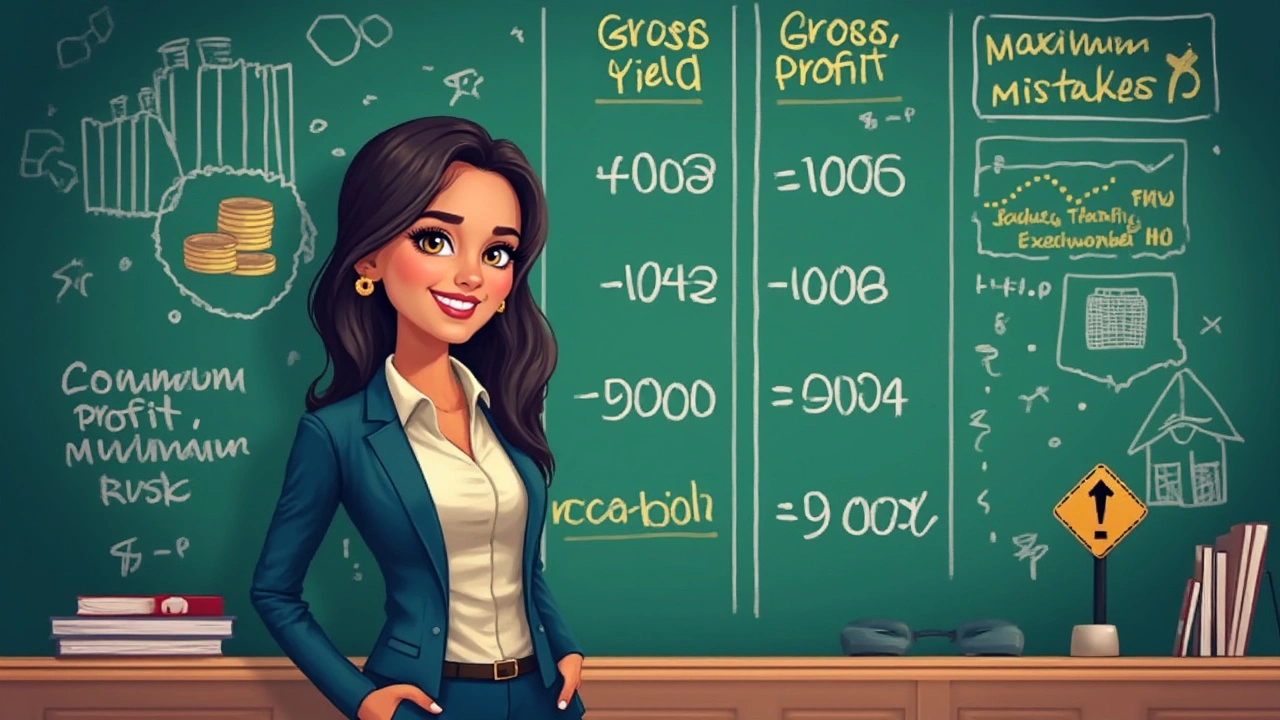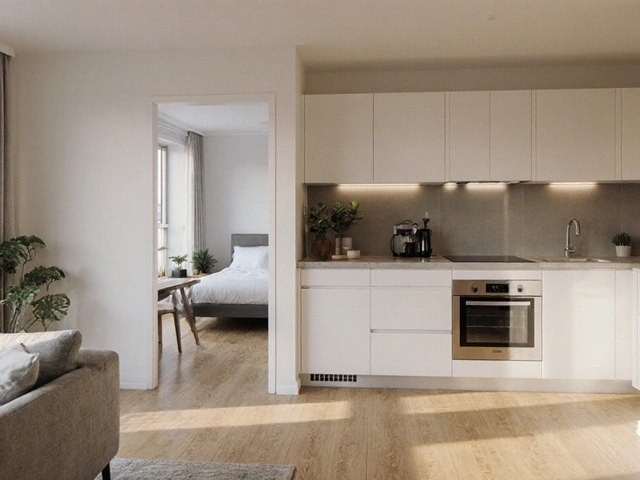Rental Property Profit: How Much Do You Really Need?

Thinking about buying a commercial property to rent out? Here's the deal—your profit margin isn't just a nice number to look at. It's the one thing that makes all your effort worthwhile. If you don't get it right from the start, things go sideways fast.
Most folks think any cash coming in is good news. But you need to know exactly how much profit you need to cover your time, stress, and money tied up in the property. That sweet spot is different for everyone, but it's always tied to hard numbers—how much cash you put in, how much rent you collect, and what expenses hammer you each month.
- Why Your Profit Margin Matters
- The Numbers That Actually Count
- Typical Profit Ranges in Commercial Rentals
- How to Boost Your Returns (Without Getting Burned)
- Common Mistakes That Kill Your Profits
Why Your Profit Margin Matters
Your profit margin isn't just a scorecard—it decides if your rental property is worth it or heading for trouble. Without a clear margin, you might end up spending years making barely more than you'd get from a simple savings account. In commercial real estate, profit margins do all the heavy lifting. They cover surprise expenses, keep your cash flow steady, and give you a cushion if a tenant bails or the market dips.
Think about this: according to CBRE’s Global Investor Intentions Survey, commercial property investors usually shoot for annual returns of 8-12%. That might sound high, but that range factors in all risks and headaches that come with big-money deals. Go below 6% and you’re likely better off hunting for safer returns elsewhere.
| Strategy Type | Typical Target Profit Margin |
|---|---|
| Commercial (office/retail) | 8-12% |
| Industrial/Warehouse | 7-10% |
| Mixed-Use | 6-10% |
Why fuss over the margin so much?
- Rental property profit lets you ride out vacancies, repairs, or late payments without panic.
- Banks look at your margin to judge if you’re a safe bet for loans on future deals.
- If you want to sell later, buyers will pay more for properties that churn out reliable profits.
The bottom line: always calculate your profit margin upfront. It’s not just a number—it's your defense against the knocks and chaos of commercial property investing.
The Numbers That Actually Count
If you’re eyeing profit from commercial rental property, a few numbers matter way more than others. It all comes down to what actually lands in your pocket after the bills are paid—so let’s cut through the noise and zoom in on the key digits investors watch like hawks.
First up is net operating income (NOI). This is just your total rental income minus all regular operating expenses, like maintenance, property management, taxes, and insurance. Don’t count your mortgage payments here—that’s not part of this calculation. A healthy NOI is usually the starting point for any good deal.
Next, let’s talk about cash flow. This is the real money you pocket after ALL bills, including your mortgage. If your cash flow is negative, that means you’re basically paying to own the building, which obviously isn’t the goal.
Now here’s the big one: cap rate, or capitalization rate. This number tells you how much return you’re getting compared to what the property cost. Most investors want a cap rate between 6% and 10% for a commercial place, depending on location and risk. Crunch it like this:
- Cap Rate = (NOI ÷ Property Price) x 100
Then there’s ROI—Return On Investment. It looks at your total profit (including after-tax and possible appreciation) versus how much cash you put down. Real-world commercial property pros usually target an ROI of 8% or more, but a rental property profit above 10% starts to get really interesting, especially if it’s steady.
Don’t forget about vacancy and repair reserves. Smart investors set aside about 5-10% of the rent for the months your place is empty or needs a fix. It keeps those "surprise" costs from wrecking your real numbers later on.
Bottom line? You can’t just wing it—if you focus on NOI, cash flow, cap rate, and ROI (while planning for those "just in case" expenses), you’ll know if a property will truly make you money—or just make you busy.

Typical Profit Ranges in Commercial Rentals
If you're curious about what a good profit looks like in commercial property, here's what most people are actually shooting for: net cash flow and return on investment (ROI). These two numbers tell you if your building is actually making money or just keeping your stress levels high.
For most commercial rental investors, an average annual ROI between 6% and 12% is considered decent. If you get something below 6%, you're basically treading water. Get into double digits and you’re beating a lot of folks out there. But before you get too excited, remember, these numbers depend a lot on location, property type, and how much you paid.
Let’s look at the typical ranges by property type. This gives you an idea of what’s standard right now in the U.S. market:
| Commercial Property Type | Average Annual ROI |
|---|---|
| Office Buildings | 7% - 10% |
| Retail Stores | 6% - 12% |
| Industrial (Warehouses) | 8% - 15% |
| Multi-Family Apartments | 6% - 10% |
Here’s a quick tip: newer investors often expect way more profit than seasoned pros because the internet is full of hype. It’s rare to score double-digit cash flow off a commercial property without taking on big risks or finding a diamond in the rough.
- If your numbers line up with this table, you’re in the right neighborhood.
- Don’t forget to factor in surprise costs like repairs, vacancies, or trouble tenants. These chip away at your actual profit fast.
Markets change, and what’s “normal” in one city could be totally off in another. Cities like Dallas and Charlotte sometimes pull higher returns, while New York and San Francisco sit lower thanks to higher prices. Always check recent local deals, not just national averages.
How to Boost Your Returns (Without Getting Burned)
If you want to squeeze more profit out of your commercial rental, don't just crank up the rent and hope tenants will pay. There are a bunch of tried-and-true methods that real investors use to bump up their returns without risking a money pit.
Let's get real—the secret isn't just about collecting more rent. The best investors keep an eye on every dollar going out, too. Property management software AppFolio found in 2024 that owners who tracked expenses monthly saw a 12% higher net income than those who only checked yearly. Little leaks in your budget turn into big holes fast.
- Spruce up, but don't splurge. Target upgrades that attract higher-paying tenants—like energy-efficient lighting, improved security, or faster internet. Skip the luxury lobby unless you're leasing to big-name brands.
- Stay on top of maintenance. Fix what breaks before it gets worse. Deferred repairs usually cost you more later and can scare off good tenants.
- Refinance when rates drop. Even a small dip in interest rates can lower your monthly payments and boost your cash flow.
- Fill vacancies fast. A month without a tenant eats into your profit more than almost anything else.
- Negotiate smarter leases. Lock in tenants for longer and include clauses for annual rent bumps tied to inflation.
Here's a quick breakdown showing just how much these moves matter to your bottom line:
| Action | Typical ROI Boost |
|---|---|
| Energy Efficiency Upgrades | 5% to 10% |
| Proactive Maintenance | 3% to 7% |
| Refinancing (1% rate drop) | Up to 8% |
| Reducing Vacancy | 7% to 12% |
And it's not just about numbers. Mindset matters. As real estate analyst Marcus Garrett says:
“Chasing higher rent is fine, but sustainable cash flow comes from smarter spending and hands-on management. The best returns come when you actively protect your investment — not just your income.”
Keep your eyes on the whole picture. Rental property profit doesn't just happen; you make it by making smart, steady moves. Play it too safe, and you miss opportunities. Go too aggressive, and you risk a bad tenant or a busted budget. Find your balance, and you'll win the long game.

Common Mistakes That Kill Your Profits
Investing in rental properties isn’t rocket science, but plenty of people slip up and watch their profits vanish. Here’s where most landlords go wrong, and how you can dodge the traps.
- Underestimating Expenses: It’s super common to leave out real costs like repairs, property management fees, vacancy periods, and even rising property taxes. The unexpected stuff always happens. To stay in the game, budget at least 20-30% of your rental income for expenses—you’ll thank yourself later.
- Forgetting About Vacancy Rates: Empty units turn your cash flow into a trickle. Most commercial spaces aren’t filled year-round, so build in a vacancy rate of at least 5-10% when you run your numbers. If you assume you’ll always be at full capacity, you’re kidding yourself.
- Overleveraging: Yes, debt can help you buy more property, but doing it with barely any money down is risky. If market rents drop or an unexpected repair hits, high mortgage payments can eat all your income—or worse, put you in the red.
- Skipping Tenant Screening: Bad tenants wreck your bottom line through missed payments and property damage. Always check credit, references, and talk to previous landlords. Commercial tenants might look solid at first but do a real deep dive. Lost rental income stings, and court battles are expensive.
- Ignoring Market Trends: Commercial property isn’t set-it-and-forget-it. Retail demand can vanish, office spaces can sit empty, and new developments nearby can cause a rent race to the bottom. Watch the neighborhood, read local news, and keep tabs on what attracts solid tenants now—not five years ago.
- Getting Greedy with Rent: Trying to squeeze out top dollar sounds smart, but overpriced properties sit empty for months. It's better to charge slightly less and keep it filled, especially when the market's softening.
To sum it up, smart investors protect their rental property profit by avoiding these traps and planning for the real world, not a fantasy spreadsheet.









Write a comment